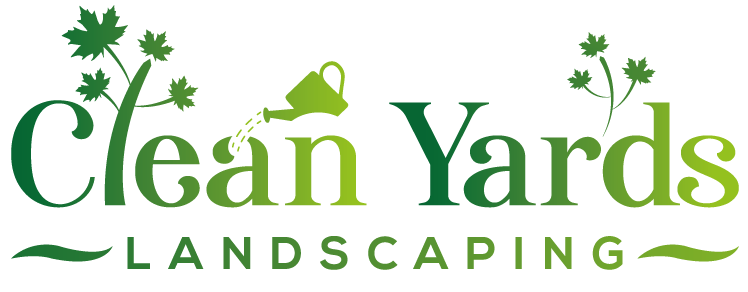Barrhaven Garden Recovery: Fix Winter Damage This Spring
Spring Garden Recovery Quick Guide:
- Assess Damage: Check lawns for snow mold, trees/shrubs for broken branches, soil for salt damage and frost heave.
- Clean Up: Gently rake debris, cut back dead perennial stems, remove fallen branches.
- Lawn Care: Dethatch/aerate if needed, overseed bare spots, apply spring fertilizer.
- Prune Wisely: Remove dead/damaged wood, prune summer/fall bloomers now, wait on spring bloomers.
- Prep Soil: Amend beds with compost once soil is workable.
Need help reviving your yard? Request a free quote today!
Introduction: Wake Up Your Barrhaven Garden! Shaking Off Winter's Chill
Well, hello there, fellow Ottawa survivors! We made it through another winter. High five! Now, let's talk about our yards. Did your Barrhaven garden hibernate a little *too* hard this year? After months buried under snow drifts (and maybe the odd lost mitten), your outdoor space probably looks less like a cheerful oasis and more like it needs a strong cup of coffee.
Don't worry if your lawn seems patchy, your flower beds are full of soggy leaves, or your shrubs look a bit frazzled. That’s just the signature look of a landscape waking up from an Ottawa winter nap! From Barrhaven to Nepean, we all face the same spring cleanup challenge.
Luckily, shaking off that winter chill and prepping for a gorgeous growing season is totally doable. Think of us as your friendly *gardening* guides. This article is designed to walk you through the essential spring recovery steps for your *landscaping*. We’ll cover everything from basic clean-up tips to getting your plants ready to thrive. Let's roll up our sleeves together and get your garden ready for sunshine and warmer days! You can see some examples of garden transformations in our transformations gallery.
Step 1: Playing Detective - Assessing Winter Damage in Your Ottawa Garden
Okay, winter’s finally loosening its icy grip! Before you dream too vividly of BBQs and blooming flowers, it’s time to put on your detective hat (a toque might still be appropriate, let's be real) and investigate what shenanigans winter got up to in your garden. Assessing the damage now helps you plan your *spring cleanup* attack for your Ottawa *gardening* space.
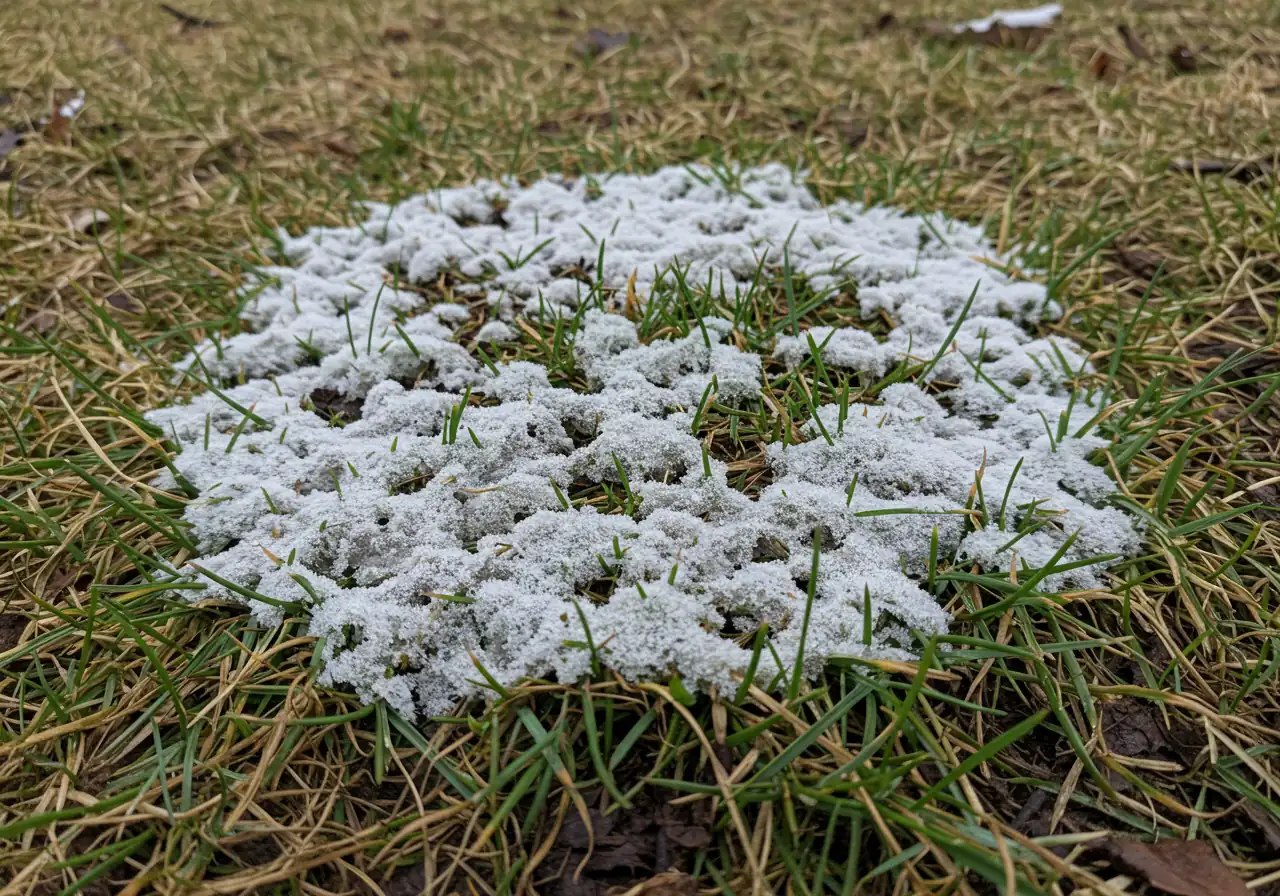
First things first, grab a notepad (or your phone) and take a stroll around your *landscaping*. Try not to stomp *too* much if the ground is still soggy – we don’t want to compact the soil more than winter already did! Look closely, because winter can be surprisingly sneaky.
What Clues Are We Looking For?
- Lawn Woes: See any weird greyish or pinkish fuzzy patches on your lawn, especially where snow lingered? That’s likely snow mold. It sounds gross, but it’s usually just surface-level stuff that a gentle rake can help clear up once things dry out. Also, check for low spots where water is pooling – poor drainage might need addressing later. Proper lawn care starts with assessment.
- Tree and Shrub Trauma: Look up! Heavy snow and ice can snap branches like twigs (pun intended!). Check your trees and shrubs for broken, cracked, or dangling limbs. Even smaller shrubs can suffer damage. Be careful around any large, unstable-looking branches – safety first!
- The Salty Situation: If you live near a road, especially in areas like Barrhaven or Nepean where salt trucks make frequent winter visits, check plants closest to your driveway or walkway. Salt spray can cause brown, dead edges on leaves or needles and stunt growth. You might see a white crust on the soil surface too. This is a common issue impacting roadside *landscaping*.
- Frost Heave Hijinks: Notice any plants looking like they tried to escape their beds? Or maybe some paving stones on your walkway seem a bit wonky? That's frost heave – the freeze-thaw cycle literally pushing things up out of the ground. This freeze-thaw action can also impact underground systems. While you're inspecting, it's a good time to visually check where your irrigation lines run; later, when you turn the system on, you'll want to know how to Fix Common Sprinkler System Problems and Save Water if leaks appear from winter damage. Proper assessment now links directly to efficient watering later; you can find more ideas on Saving Water with Smart Summer Irrigation Tips.
- Critter Capers: Were rabbits or voles using your shrubbery as an all-you-can-eat winter buffet? Look for gnawed bark at the base of trees and shrubs, often just above where the snow line was. Voles might also leave little trails or tunnels across the lawn.
- Hardscaping Headaches: Don't forget your non-living elements! Check patios, walkways, retaining walls, and even that spot you eyed for a new feature. Did the winter shifts cause cracks or instability? Assessing the state of your existing patio might even spark some inspiration for Creative Patio Design Ideas for Summer Fun. Thinking ahead, if you're considering enhancements like a fire pit, ensure the ground is stable after winter; check out these Essential Fall Fire Pit Design and Safety Tips which often require a solid foundation unaffected by frost heave.
Quick Recap: Winter Damage Checklist
- Snow mold (grey/pink patches on lawn)
- Broken or damaged tree/shrub branches
- Salt damage (browning edges, near roads/walkways)
- Frost heave (uprooted plants, uneven pavers/stones)
- Animal damage (gnawed bark, tunnels)
- Cracked or shifted hardscaping (patios, walls)
- Compacted soil or poor drainage areas
Taking stock now sets you up for success. If the damage seems overwhelming or you need help tackling bigger issues like significant tree damage or extensive lawn repair, remember there are professional Landscaping and Yard Cleanup Services available right here in the Ottawa area to lend a hand. Next up, we'll talk about the actual clean-up process!
Step 2: The Big Spring Clean-Up: Clearing the Way for Growth
Okay, detective work done! You've surveyed the scene and know what winter left behind. Now comes the satisfying part: the actual *spring cleanup*! Think of it as giving your yard a good stretch and a tidy-up after its long winter nap. Whether you're in Manotick, Richmond, or anywhere else around Ottawa, these steps will help clear the way for beautiful new growth.
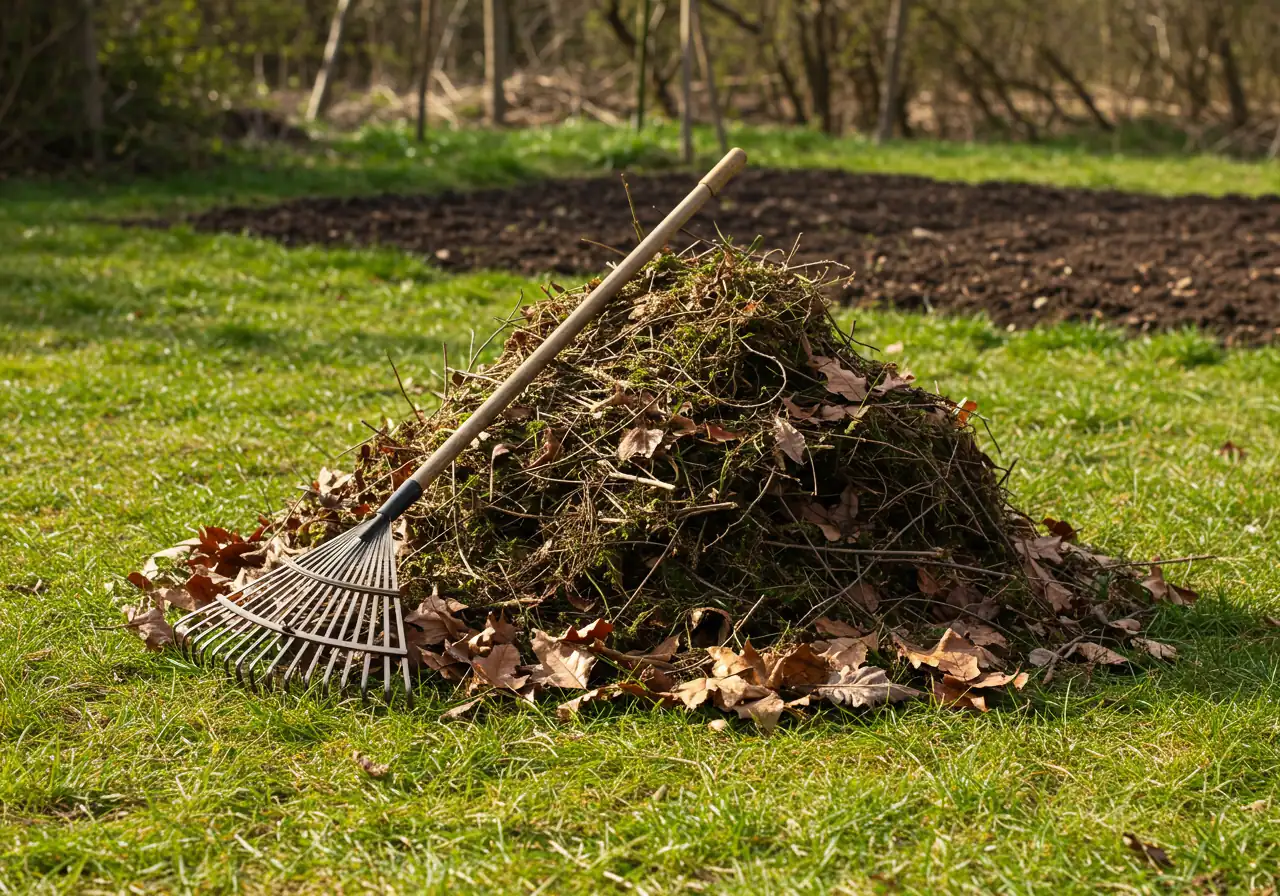
Let's Get Physical (But Gently!):
- Rake It 'Til You Make It: Grab your rake, but maybe leave the super stiff one in the shed for now. If your lawn is still a bit damp (which it likely is in early spring), rake gently. We want to lift off the dead leaves, twigs, fallen debris, and maybe even expose that snow mold you spotted in Step 1, without tearing up the turf. Think fluffing, not scraping! This simple *lawn care* step improves air circulation, which grass loves. Clear out those garden beds too, removing the soggy leaf mat that’s smothering emerging plants. You might even find treasures, like that missing garden gnome... or just more leaves.
- The Perennial Haircut: Remember those brown, dried stalks from last year’s flowers and ornamental grasses? It's time for their spring trim! For most *perennials*, cut the dead stems back close to the base, usually leaving just a few inches. *But watch out!* Look closely for tiny green shoots of new growth emerging from the crown (the base) of the plant – you don't want to snip those! For ornamental grasses, cutting them back now makes way for fresh, vibrant blades.
- Branch Management: Pick up all those smaller twigs and branches that winter winds scattered across your *landscaping*. If you found larger broken limbs during your assessment (Step 1), deal with those carefully. Anything too big or high up? Don't risk it – calling in professionals might be wise. A thorough cleanup prevents pests from making homes in the debris.
Tidying Up the Mess:
All that stuff you raked and snipped? Don't just pile it by the curb immediately (unless it's your designated yard waste day! Check the City of Ottawa Green Bin and Leaf/Yard Waste collection schedule). The *best* thing you can do is start a *compost* pile or add it to your existing one. Leaves, small twigs, and dead plant matter break down into amazing food for your *gardening* efforts later. If composting isn't your jam, check Ottawa's green bin or yard waste collection schedule. Some jobs generate a lot more debris than expected; if you're facing a mountain of yard waste, consider reaching out for help. Many homeowners find using a dedicated Barrhaven garden clean up service or similar options in their area saves a ton of time and hassle. For larger properties needing more than just garden attention, a comprehensive Ottawa property cleanup service can tackle everything.
Finishing Touches:
Once the major debris is gone, redefine your garden bed edges with a spade for a crisp look. Gently loosen the very top layer of soil in your beds if it's dry enough – this helps water and air reach plant roots. *Don't* work the soil if it's muddy, as this causes compaction.
Feeling a bit overwhelmed by the scope of work? That's totally okay! Many folks choose to bring in professional spring cleanup services to get the job done quickly and efficiently. You can usually get a free estimate and see client feedback online – just be sure you understand how we handle your information according to our privacy policy when requesting quotes. View examples of our cleanup work on our Google My Business page.
With the clutter cleared, your garden can finally breathe! Next, we'll talk about waking up the soil itself.
Spring Lawn Care Focus
Focus on gentle raking, assessing for snow mold, planning for aeration/dethatching if needed, and preparing for overseeding thin areas. Avoid heavy traffic on soggy turf.
- Rake lightly when dry
- Check for compaction
- Plan fertilization
- Learn about Lawn Care services
Garden Bed Preparation
Clear dead leaves and stalks, prune dead/damaged perennial growth, check soil moisture before working it, and plan for adding compost or mulch later.
- Remove debris
- Cut back dead stems
- Assess soil readiness
- Plan soil amendment (Soil Prep Info)
Hardscape Winter Check
Inspect patios, walkways, and retaining walls for shifting, cracks, or damage caused by freeze-thaw cycles. Check for drainage issues around hardscaped areas.
- Look for cracks/tilting
- Check joint stability
- Ensure proper drainage
- Plan repairs if needed
Step 3: Lawn CPR: Reviving Your Turf After a Tough Winter
Okay, the initial cleanup is done, but your lawn might still look like it went twelve rounds with winter and lost. Don't despair! It’s time for Step 3: Lawn CPR. We're going to revive that tired turf and get it breathing again, ready for a glorious Ottawa summer. A lush lawn really boosts the curb appeal, especially in lovely communities like Osgoode or Metcalfe, so let's get to work!
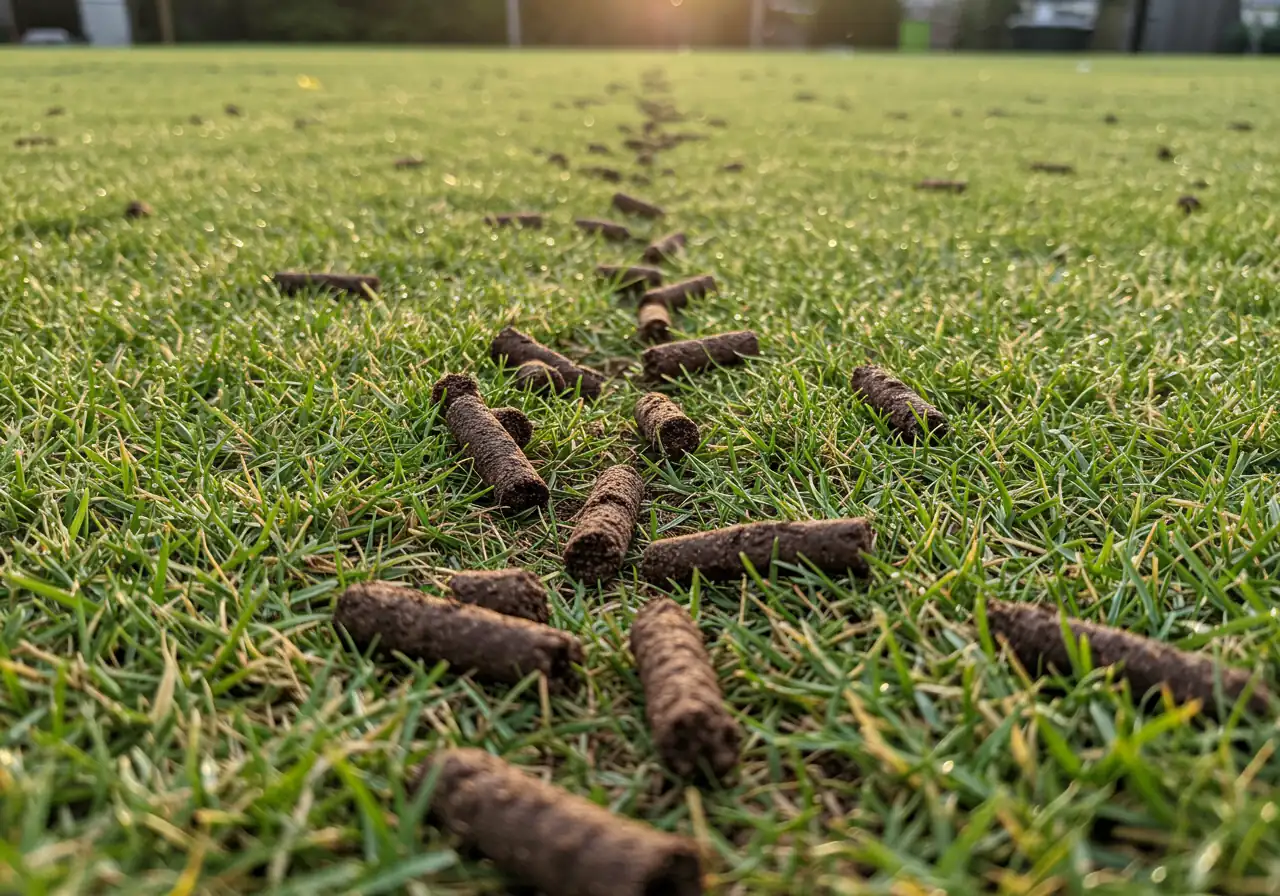
First Aid for Lingering Winter Woes:
Remember that greyish snow mold we talked about? Usually, the gentle raking you did in Step 2 and improving air circulation is enough to kick it to the curb as things dry out. For salt damage near driveways or walkways, give the affected area a good, deep watering once the ground thaws. This helps flush the salt down below the root zone. If it’s really bad, you might need to replace the damaged turf later.
Giving Your Lawn Room to Breathe: Dethatching and Aeration
Think of thatch as a thick, spongy layer of dead grass stems and roots tangled up just above the soil surface. A little is fine, but too much (more than half an inch) acts like a raincoat, blocking water, air, and nutrients from reaching the soil and roots.
- Dethatching: This is basically giving your lawn a good comb-out. For small areas, a stiff dethatching rake works. For larger lawns, renting a power dethatcher might save your back! Wait until the lawn is relatively dry. Raking up the thatch can create a surprising amount of debris; if it's more than your green bin can handle, incorporating it into a larger yard cleanup strategy might be needed. Sometimes, a full Ottawa property cleanup service is the easiest way to deal with all the spring refuse at once.
- Aeration: After a long winter under heavy snow, Ottawa soil can get seriously compacted, making it hard for grassroots to grow deep and strong. Aeration involves pulling small plugs of soil out of the lawn (core aeration is best). These holes allow precious air, water, and fertilizer to get right down where they're needed most. It looks a bit funny initially, but your lawn will thank you! You can rent aerators, or this is another task where calling in the pros makes life easier.
Patching Things Up: Overseeding
Got bare spots? Thinning areas? Winter kill patches? Overseeding is your friend. It’s simply spreading grass seed over your existing lawn. Doing this after dethatching or aerating is ideal because the seed makes better contact with the soil.
- Choosing Seed: For our Ottawa climate, blends containing Kentucky Bluegrass (loves sun, good recovery), Fescues (more shade and drought tolerant), and Perennial Ryegrass (germinates quickly, good for patching) often work best. Check the seed bag label for the blend specifics. Proper material selection is key.
- How-To: Spread the seed according to the package directions (a spreader helps for even coverage). Lightly rake it in so it contacts the soil. *Crucial step:* Keep the seeded areas consistently moist (light watering daily, maybe twice) until the new grass is established.
Feeding Time: Fertilization
Your lawn is waking up hungry! A spring feeding helps it green up and grow strong. Use a quality lawn fertilizer, preferably a slow-release formula designed for spring. *Don't overdo it!* Too much fertilizer can harm your lawn and the environment. Follow the package instructions carefully. For best results, a soil test tells you exactly what nutrients your lawn needs, but a balanced spring fertilizer is a good general start. Resources like the Master Gardeners of Ottawa-Carleton can offer general advice on local lawn care.
Putting in this effort now sets the stage for easier summer upkeep. Consistent care is key for long-term lawn health, something covered under comprehensive garden maintenance plans. For that really polished look after all your hard lawn work, consider defining the borders with professional mulching and edging.
Feeling like this Lawn CPR is a bit much to handle on your own? No shame in that! Lawn revival, especially aeration and dethatching, can be hard work. If you'd rather leave it to the experts who know Ottawa lawns, you can easily book a free estimate online. We're local folks who love helping our neighbours achieve beautiful yards – you can learn more about us and our commitment to quality service. Check our client portal if you're an existing customer: Customer Portal.
Step 4: Pruning Power & Plant TLC: Waking Up Your Shrubs, Trees, and Perennials
Okay, the yard is clear, the lawn's getting some attention – now it’s time to wake up the sleeping beauties: your shrubs, trees, and perennials! Step 4 is all about smart *pruning* and giving your plants the TLC they need to burst forth with spring energy. Think of it as a gentle nudge and a spa day, all rolled into one.
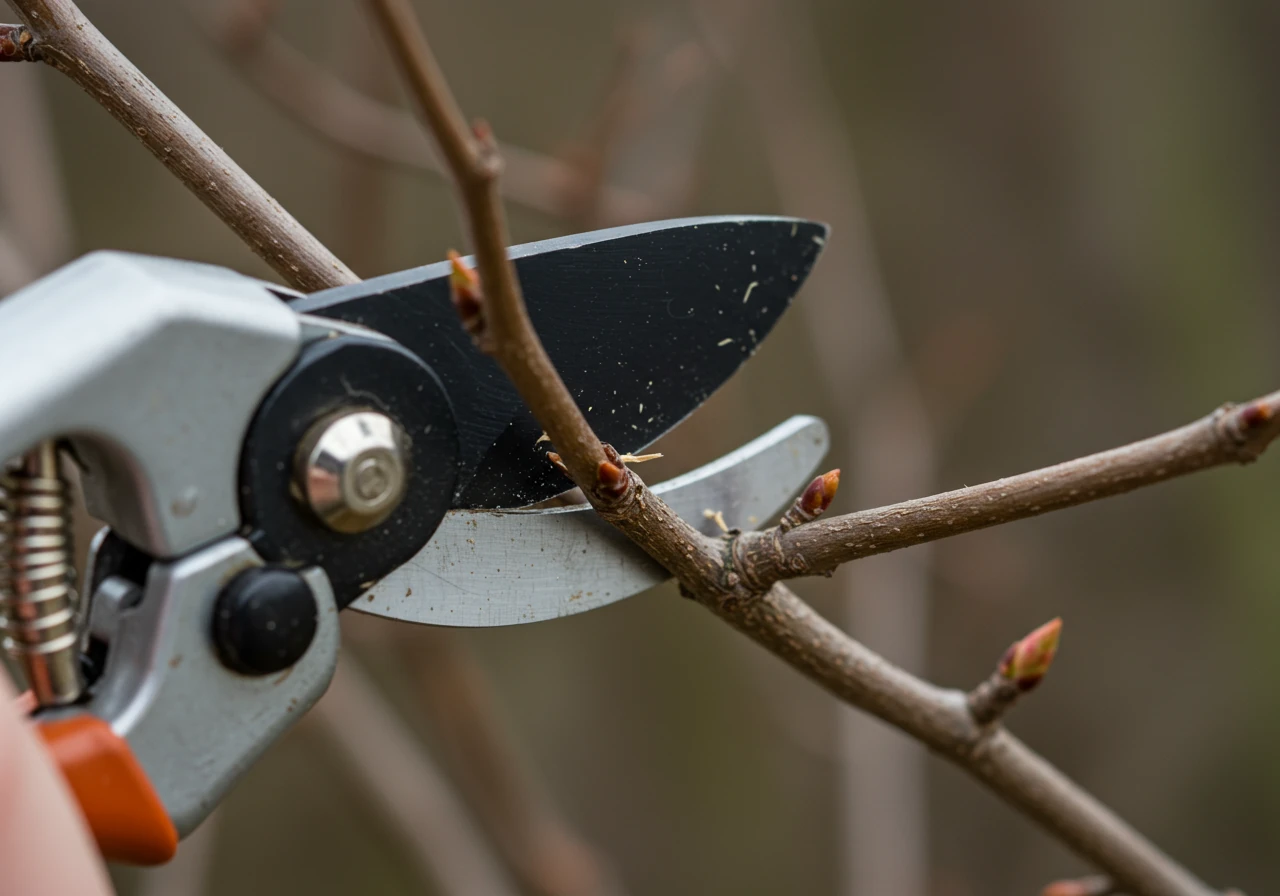
Pruning Power: The Spring Haircut
After a tough Ottawa winter, a little tidying up does wonders for plant health and appearance. But don't just start hacking away like a gardening ninja! There's a method to the madness.
- Know Your Target - The 3 D's: Your main targets for *spring pruning* are the Dead, Damaged, and Diseased branches. Remove anything broken by snow or ice, twigs that are clearly dead (they'll be dry and snap easily), or branches showing signs of disease. Also, prune out branches that are crossing and rubbing against each other – this prevents wounds that invite pests and disease.
- Timing is Key (Mostly!): For most shrubs and trees that bloom in the summer or fall (like hydrangeas or potentilla), late winter or early spring – *before* major new growth starts – is the perfect time to prune. This encourages vigorous growth.
- BUT... Hold Your Clippers! (The Spring Bloomer Exception): Got Forsythia? Lilacs? Magnolias? Anything that puts on a spectacular flower show *early* in spring? Do NOT prune these now! These plants form their flower buds on last year's wood. If you prune them before they bloom, you'll cut off all the flowers. Wait until *after* their flower show finishes, then give them their haircut.
- The How-To: Use clean, sharp pruners or loppers. Make your cuts just above an outward-facing bud or branch junction, angling the cut slightly so water runs off. For larger branches, especially on mature *trees* perhaps found in older gardens around *Kars* or *Kenmore*, safety first! If it requires a ladder or looks tricky, calling a professional is always the best bet. Dealing with tricky pruning cuts or unsure about a specific plant? Knowing who to trust matters. You can learn more about us and our local expertise in handling Ottawa gardens.
Waking Up Perennials and Roses
- Perennials: You probably cut back most dead stems in Step 2. Now, gently check the base (crown) of your *perennials* for signs of new green shoots. Be patient; some plants are late sleepers! Gently loosen the soil around them if it’s workable (not muddy). Sometimes pruning reveals that a beloved plant just didn't make it through the winter, leaving a gap. Don't despair! It's an opportunity. Think about introducing something new and exciting with a fresh garden install suited to our climate.
- Roses: Remove any winter protection (like rose cones). Prune back any dead, blackened canes to healthy wood (look for green inside the stem). Aim to remove weak, twiggy growth and shape the plant.
A Little Extra TLC & Ottawa Weather Watch
Gently scratch the soil surface around your plants (avoiding surface roots) to help air and water penetrate. Check your *mulch* levels – you might need to top it up later once the soil warms, but for now, make sure it isn't smothering emerging shoots.
And remember, this is Ottawa! We can still get surprise late frosts well into May. Keep an eye on the forecast. If frost threatens after tender new growth has emerged, cover sensitive plants overnight with old sheets, buckets, or frost cloth. Environment Canada is a good resource for local forecasts.
All those pruned branches and debris can add up fast! If it’s more than your green bin can handle, remember that comprehensive help is available. Whether you need a general Ottawa property clean up or specific help like our dedicated Marionville property cleanup service, getting the debris removed professionally clears the way for growth. If you prune back shrubs severely and realize the lawn underneath suffered winter kill, refreshing that area might be part of the plan. Sometimes, laying new turf is the quickest fix; you can explore options for professional sod installation in Ottawa if needed.
With a bit of careful pruning and attention, your plants will be ready to reward you with a season of beauty!
Ideal Spring Garden Recovery Timeline
Early April
Assess damage, gentle rake leaves/debris (if ground not soggy), check hardscaping, remove large broken branches.
Mid-Late April
Cut back perennials/grasses, prune summer/fall blooming shrubs (NOT spring bloomers), dethatch/aerate lawn if needed.
Early May
Overseed lawn patches, apply spring lawn fertilizer, start amending garden beds with compost (if soil workable).
Mid-Late May (After Frost Risk)
Plant tender annuals, top up mulch, prune spring-blooming shrubs (after flowering), set up irrigation systems (check for issues!).
Step 5: Feeding the Soil & Prepping for Planting: The Groundwork for Success
Okay, team, we've cleaned up, assessed, woken up the lawn, and given our existing plants a little spa treatment. Now for the *really* exciting part: setting the stage for new growth! Step 5 is all about feeding the soil and getting those garden beds ready for planting. Think of it as making a comfy, nutrient-rich bed for your plant babies – get this right, and you're halfway to a gorgeous garden.
Why Your Soil Needs Some Love (Especially After Winter)
Let’s be honest, Ottawa soil can be… challenging. We often deal with heavy clay that gets compacted over winter, making it tough for roots to grow and water to drain properly. Or maybe you have sandy soil that water just runs right through! Winter freeze-thaw cycles can also mess with soil structure. Giving your soil a boost now is like giving your plants a multi-vitamin and a comfy mattress all in one. Healthy soil is the absolute foundation of successful *gardening*.
The Secret Weapon: Organic Matter!
So, how do we fix grumpy soil? The magic answer is *organic matter*. This is simply decomposed natural material like compost, well-rotted manure, or leaf mold. Adding this stuff works wonders:
- For Clay Soil: Organic matter helps break up the dense clay particles, improving drainage and allowing air to reach the roots. No more plant feet stuck in cement-like mud!
- For Sandy Soil: It acts like a sponge, helping the soil hold onto moisture and nutrients that would otherwise wash away.
- For All Soils: It provides essential nutrients, encourages beneficial soil microbes (think tiny underground helpers!), and improves overall soil structure.
Prepping Your Garden Beds: Keep it Simple
Ready to get your hands dirty? Here’s how to prep those beds:
- Check for Workability: Grab a handful of soil and give it a gentle squeeze. If it forms a tight, muddy ball or water drips out, it’s too wet! Wait a few days for it to dry out a bit. Working wet soil leads to compaction – exactly what we *don't* want.
- Loosen Up: Once the soil is crumbly, gently turn or loosen the top 6-8 inches with a garden fork or spade. You don't necessarily need to double-dig the whole thing unless you're creating a brand-new bed or dealing with severe compaction.
- Add the Good Stuff: Spread a generous layer (2-4 inches) of compost or other organic matter over the surface.
- Mix it In: Gently work the organic matter into the loosened soil. Don't pulverize it; just mix it reasonably well. Proper Soil Preparation is key.
- Rake Smooth: Give the bed a final rake to level it out, and voilà! It’s ready for planting.
This soil prep work can feel like a big job, especially if you have large garden areas, maybe out in Winchester or Embrun way. If tackling heavy soil feels daunting, remember there are local pros who can help. Assistance with tasks like amending soil is often part of a thorough Metcalfe garden clean up service or similar packages designed for specific areas, like our comprehensive Marionville garden clean up service.
Choose Wisely: Planting for Ottawa Success
Now that your soil is primed, think about *what* you'll plant. Ottawa is generally in Plant Hardiness Zone 5a. This means choosing plants rated for Zone 5 or lower is crucial for winter survival! Look for hardy *perennials*, *shrubs*, and *trees* that thrive in our climate. Local nurseries are great resources for finding suitable plants. If you're planning a bigger project or need ideas, exploring options for a new professional garden install can ensure you get the right plants in the right place. See examples in our gallery.
Quick Early Spring Planting Calendar (April-May):
- April: Assess soil, amend beds once workable. Plant cool-season veggies (peas, lettuce, spinach) if desired. Start planting hardy trees and shrubs.
- Early-Mid May: Plant most hardy perennials. Continue planting trees and shrubs. Keep an eye on frost warnings!
- Late May/Early June: *After* the last frost date (usually around Victoria Day weekend, but watch the forecast!), it's safer to plant tender annuals and warm-season veggies (tomatoes, peppers).
Getting the soil right is the groundwork for a season of beauty. If you have any questions about prepping your specific soil type or choosing the right plants, don't hesitate to ask! You can easily contact us for advice or a quote. We genuinely appreciate you considering us for your garden needs; check out our thank you page for customer feedback to see what others say about our work. Happy planting!
Quick Wins! 3 Easy Steps for Instant Spring Garden Improvement
Need a fast fix for your post-winter Ottawa garden? Try these easy wins for instant impact:
- Targeted Tidy-Up: Spend just 20 minutes raking the *most obvious* leaves and debris from key spots on your lawn and garden beds. Clearing surface clutter makes a huge difference! For overwhelming messes, our expert Marionville yard cleanup service is ready to help.
- Edge Definition: Use a spade to quickly sharpen the edge along one visible pathway or flower bed. Crisp lines instantly improve your *landscaping* look. Need the whole place done? A thorough Metcalf property cleanup service can handle full edging beautifully.
- Quick Snips: Prune only the clearly dead or broken twigs off main shrubs near your door. It’s a mini-makeover! Check out finished results and get inspired by our Clean Yards project gallery. For more in-depth work beyond quick snips, our dedicated Marionville garden clean up service includes detailed pruning.
Barrhaven & Ottawa Garden Recovery FAQs
Great question! Avoid heavy trampling or digging when the ground is still soggy – wait until it crumbles easily. Gentle raking of leaves off lawns and beds can often start in April. For major *gardening* work like dividing *perennials* or heavy soil turning, waiting until late April or early May, when the soil warms and delicate shoots are clearly visible, is usually best to avoid damage from late frosts or compaction.
Don't panic, that Ottawa winter look is common! Gently rake the greyish snow mold patches once the lawn is dry to improve air circulation – it usually recovers. For thin spots, wait until the ground isn't soggy, then consider dethatching or aeration followed by overseeding. Improving soil contact and adding new seed is key for filling in those bare areas and reviving your turf.
Ah, Ottawa clay! The simplest, most effective fix is adding organic matter. Spread a few inches of compost or well-rotted manure over your garden beds *after* the soil is workable (not wet!). Gently mix it into the top 6-8 inches. This improves drainage and adds nutrients. For more tips, check out our guide on proper Soil Preparation. It makes a huge difference for happy plants!
Hold those pruners for a sec! While removing damaged branches is good, avoid just hacking them off randomly. Look for the 'branch collar' (the slightly swollen area where the branch joins a larger stem) or an outward-facing bud. Make a clean cut just outside the collar or slightly above the bud. This helps the plant heal properly and encourages healthy new *landscaping* growth.
Sometimes! Once the ground thaws completely, try flushing the soil around affected plants with plenty of water. This can help wash away some residual salt from the root zone. Unfortunately, severe damage might be irreversible. It's worth noting that recovery isn't guaranteed, as factors beyond our control affect plant health; understanding service scope is covered in our Terms and Conditions. Planting salt-tolerant species in those areas can help next time.
You're definitely not alone! Spring *gardening* cleanup can be demanding. If tackling it yourself feels overwhelming, hiring professional help is a fantastic option. Companies offer specialized spring services to get your yard back in shape quickly. You can easily find an Ottawa Yard Cleanup Service or look for providers in nearby areas like the Metcalf Yard Cleanup Service to handle the heavy lifting for you. Our specific Ottawa Garden Clean Up Service focuses on garden beds, while the Property Clean Up service is more comprehensive.
Common Winter Damage & Spring Fixes
| Damage Type | Signs | Primary Spring Fix | Related Service |
|---|---|---|---|
| Snow Mold | Grey/pink fuzzy patches on lawn | Gentle raking, improve air circulation | Lawn Care |
| Broken Branches | Cracked, dangling, or snapped limbs | Prune back to healthy wood/branch collar | Garden Clean Up |
| Salt Damage | Browning leaf/needle edges near roads | Flush soil with water, consider salt-tolerant plants | Garden Install |
| Frost Heave | Uprooted small plants, uneven pavers | Gently reset plants, level pavers | Garden Maintenance |
| Compacted Soil | Poor drainage, weak lawn growth | Core aeration (lawn), amend beds with compost | Soil Preparation / Aeration |
Conclusion: Get Growing! Enjoy Your Revitalized Barrhaven Oasis
And there you have it! From playing detective with winter damage to giving your lawn some CPR and prepping that precious *soil* for *planting*, you're now armed with the know-how to wake up your Barrhaven garden. We've covered the essential *spring cleanup* steps, tackled *pruning* mysteries for *shrubs* and *trees*, and set the stage for healthy *perennials*. Remember, a little effort now pays off big time later, transforming your yard from winter-weary to wonderfully welcoming. Think of all the sunny afternoons you'll spend enjoying your revitalized *landscaping*!
Taking these steps isn't just about chores; it's about investing in your own slice of Ottawa nature, creating a beautiful space to relax and recharge. Whether you're in Barrhaven, Greely, or anywhere else nearby, you deserve an outdoor oasis to enjoy.
Feeling inspired but maybe a bit short on time (or rake-power)? No worries! If tackling the *gardening* tasks yourself feels like too much, we're here to help. Our professional teams offer comprehensive *spring cleanup*, ongoing *lawn care*, and full *garden maintenance* services across the Ottawa region. Let us handle the hard work so you can jump straight to the enjoyment phase! Ready to reclaim your weekends and love your yard?
